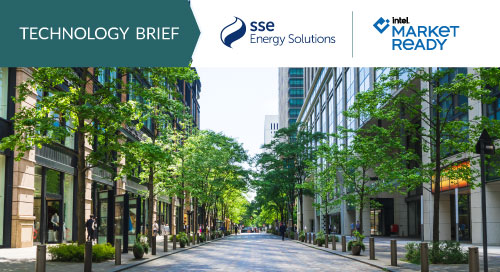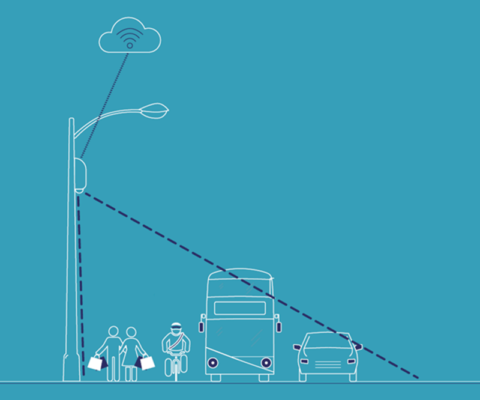Fill form to unlock content
Error - something went wrong!
Stay up-to-date with the latest IoT news.
Subscribed.
Edge AI Advances Sustainable Smart Cities

Cities and towns everywhere want to improve air quality, liveability, and traffic flow. But when it comes to creating solutions, they often operate in the dark.
“Many towns have antiquated methods of counting traffic volume and pedestrian activity, and rely on anecdotal information to make planning, policy, and investment decisions,” says Patrick Mitchell, Head of Smart Cities and Places for SSE Energy Solutions, a division of UK-based energy provider and distributor SSE.
The lack of evidential data makes it difficult to justify spending taxpayer money on green projects that may or may not work as intended or forecasted. And once a new walking trail, access road, or park-and-ride system is up and running, officials lack the means to measure its effects. As a result, many of those in local government are challenged to progress beyond baby steps toward achieving their sustainability goals.
New AI-based optical sensor systems are starting to change the picture. By collecting and analysing data linked to traffic and pedestrians, in combination with information from environmental sensors and other sources, officials can make evidence-based decisions supporting green projects. Once the new solutions are deployed, results can be monitored with outcomes influencing optimisation and change as towns grow and transform.
Smart Spaces Lower Energy Costs, Boost Safety
Though IoT sensor technology is complex, it can be easily deployed on streetlight poles. SSE has been doing just that since 2010, developing remotely controlled streetlights for local authorities, including Hampshire County Council and Southampton City Council. SSE solutions have since been installed on more than 400,000 light poles in the UK and Ireland.
Sensors attached to the poles enable town administrators to remotely turn on, turn off, or dim lights, helping reduce energy costs and lower their carbon footprint. And if a nighttime incident occurs, authorities can literally “shed light” on the problem for arriving emergency crews.
“Replacing anecdotal evidence with hard #data is a very powerful #tool that allows local authorities to substantiate policy changes” – Patrick Mitchell, via SSE Energy Solutions @insightdottech
Building Sustainable Smart Cities
The street lighting control deployment has been followed by the development of the SSE Sentinel optical sensor. Installed on light poles in Cornwall, Slough, and Pembrokeshire, and other locales), optical sensors capture in-depth information about street activity—giving town administrators the tool they need to advance greener planning.
Running on a lightweight AI edge gateway, Sentinel collects and processes detailed images of vehicle and pedestrian traffic. It securely sends select data over a cellular network to the SSE Smart City and Places platform, where it can be visualised and analysed for planning and evidential insights (Figure 1).

“The data reveals and highlights classifications such as heavy-goods vehicle, light goods vehicle, taxis, buses, motorcycles, e-scooters, etc.,” Mitchell says. “It also provides pedestrian data, which can include flow and movement path.”
To process data-heavy images in near-real time, the solution uses high-performance Intel® processors. Algorithms deployed through the Intel® OpenVINO™ Toolkit can scrub private details such as facial features and license plate numbers, transmitting only information that towns and cities need.
Customers can combine the sensor data with information about season, time of day, weather, and critically, air quality.
“Local authorities might find a direct correlation between air quality degradation and the number and types of vehicles going through a particular area. Replacing anecdotal evidence with hard data is a very powerful tool that allows them to substantiate policy changes,” Mitchell explains.
For example, many planners focus on revitalising their town’s main commercial streets, where noise and fumes from through-traffic can discourage pedestrians and shoppers. Collecting and analysing data linked to air quality, vehicle traffic, and pedestrian movement can support change. Officials may decide to reroute traffic, lower speed limits, develop green pathways for cyclists and pedestrians, or build park-and-ride systems. “Getting people out of fuel-guzzling cars and into public transport is a major goal for local authorities,” Mitchell says.
Cities can also schedule public works projects to be less disruptive. “If you have evidence that a road closure or maintenance has a direct impact on commerce, you can ask, ‘Was that the right time for this activity, or could we have done it in a different way?’” Mitchell says.
Once a solution is in place, officials can monitor traffic, air quality, and pedestrian activity to see how well it is working. Positive results could increase public confidence and pave the way for more sustainable projects.
AI and City Planning
As environmental and sustainability concerns grow, cities and communities are likely to extend their use of smart spaces, Mitchell believes. For example, sensors in water drainage systems could detect pipe blockages and inform maintenance crews. By combining this data with historical information about floods and weather conditions, city officials could predict the effects of an upcoming storm and prioritise fixes to minimise flood damage.
Predictive analytics and smart technologies could also help authorities roll out smart and sustainable initiatives more efficiently.
“Electric vehicles will replace traditional petrol and diesel transport in the coming years. Planners need to know where to place EV charging hubs and enhance the infrastructure that carries that electricity, because it simply isn’t adequate in all locations at the moment,” Mitchell says.
As cities scrutinise their energy use more closely, they may decide to use artificial intelligence analytics as the backbone of carbon trading systems. “Data and analytics will be vitally important,” says Mitchell. “We believe software platforms will underpin the management and planning of infrastructure in the future.”
This article was edited by Georganne Benesch, Associate Editorial Director for insight.tech.